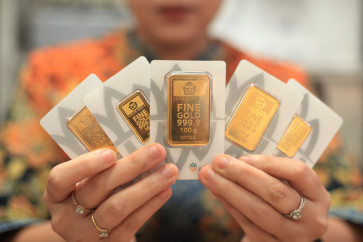Popular Reads
Top Results
Can't find what you're looking for?
View all search resultsPopular Reads
Top Results
Can't find what you're looking for?
View all search resultsLifting the veil on headscarves
Heading out in style: Headscarves are available in a range of styles, as more women choose to embrace the garment, but ditch the conservative look
Change text size
Gift Premium Articles
to Anyone
Heading out in style: Headscarves are available in a range of styles, as more women choose to embrace the garment, but ditch the conservative look. JP/J. ADIGUNA
There's the Gelombang Cinta (love wave) style, the Rianti Cartwright type, the Teh Ninih variety and the Paris Square trend.
We're not talking about mundane fashion trends here. This is religious fashion. This is about how Islamic women choose to cover their heads, necks and busts. In a way, it's about being religiously fashionable. Devoted, as it were.
It used to be as simple as a wide square scarf folded to make a triangle, positioned on the head in a certain way and pinned in place. But as more women want to embrace the headscarf but ditch the conservative look, it's just not that simple anymore.
"People are into the Paris style nowadays," says Fitri, a shop assistant attending to customers in Jilbab Cantik, a shop in Cibubur, East Jakarta. "You know, the slip-on headscarf that comes with a chiffon layer that covers the shoulders."
Before the Paris the rage was for the style that actress Rianti Cartwright wore in the much-hyped movie Ayat-Ayat Cinta (Verses of Love). This style comes with an extra-large pashmina scarf that can be worn as an additional veil over the headscarf.
Women who want to start to "educate" their daughters to wear headscarves can opt for a modified type called variously the Koala, the Cow, the Butterfly or the Reindeer, a slip-on headscarf for kids with "ears" on top.
While Jilbab Cantik offers customers the designs of its owner Erina Riyanto, most other small Islamic boutiques selling the clothing item depend on supplies from wholesalers in Tanah Abang, most of whose collections come from Bandung and Tasikmalaya.
In an era where the line between being religious and being religiously fashionable is increasingly slender, boutiques and shops in malls and markets are filled with so-called Islamic attire, and not only in the pious days leading up to Idul Fitri.
Sets of Islamic attire, which include headscarves of a higher class, are also available through the lines of designers Itang Yunasz, Anne Rufaidah, Ida Royani and Bandung-based Shafira House.
Just like any other fashion accessory, headscarves vary wildly in price, from Rp 35,000 to Rp 500,000 a piece.
But although the jilbab - the term widely used for Islamic headscarves and dresses - is a traditional element associated with the religion, it was not until after 2000 that the item really picked up in the fashion market.
Back in the 1980s when Anne Rufaidah started her line, people laughed at her, she says. Former singer Ida Royani describes a similar experience, saying people mocked her for being a "ninja" when she took to wearing a headscarf.
As Heri Setiawan, a researcher at Surabaya's Airlangga University, wrote, in Indonesian culture, the jilbab has become a symbol that can carry a range of meanings, often political.
It was the symbol of the reemergence of Islamic glory represented by the Iranian revolution in 1979, which Indonesian middle-class Muslims adopted. It became a symbol of resistance during the repressive Soeharto regime. And in its early years, it was the garment of the marginalized, the people from the kampung.
"In the 1980s, Indonesian Muslims were inspired by the Iranian revolution," says Islamic scholar Nong Darol Mahmada. "Religious movements sprouted and that was partly represented symbolically by women with headscarves."
The headscarves that we know today - those that completely cover the head and neck - did not even exist before that time.
"What was actually the Indonesian version of it is a kerudung," Nong says, referring to a long scarf that loosely covers the head.
The word jilbab, derived from the Arabic word jalaba, which means to bring together and carry, refers to an outer garment covering a woman from head to toe.
Historically, veil has been in use since the Hammurabi era. In ancient Mesopotamian cities, including Babylonia and Assyria, veils were a status symbol for women of the upper classes. Later on, middle-class women also took to wearing the garb.
It was also during this era that the seclusion of women was incorporated into socio-cultural mores. During the Byzantine-Persian wars (the sixth to seventh centuries AD), the culture of veiling spread to Arabian coastal cities, which had become the new trading hubs. Damascus and Baghdad were at the center of the cultural assimilation.
Thus, what originally was something of a Persian origin was adopted as part of Arab culture, in the birthplace of Judaism, Christianity and Islam.
That is why similar concepts are also found in Jewish literature, in which the law requiring women to be covered was based on the so-called inherited sin of Hawa, the first woman on earth, of seducing her husband Adam. Catholic nuns also wear head covers as a religious symbol.
According to Nong, the Islamic concept of hijab or veiling oneself has its roots in the response toward the culture in pre-Islamic Arab civilization of walking in public uncovered and bare-chested.
Nong's analysis finds that, in a way, the Islamic teaching of having a woman cover herself totally is political, discriminative and elitist. To this day, clerics have different interpretations on a woman's obligation to cover parts of her body.
The essence of such teachings actually lies in the value of modesty, she says.
Yet the political and religious have turned into a fashion commodity. The emergence of trendy and fashionable jilbab is seen by some as a profane and banal take on something sacred.
Worse, commentators say, it has even been politicized, with some arguing that male presidential candidates for the upcoming elections will win more votes if their wives wear headscarves - a phenomenon that Muslim scholar Siti Musdah Mulia calls "a sad reality".
It is perhaps just another example of religion or any symbol of religion being made inseparable from the struggle for power - being exploited as a tool to win over the masses.
In Western countries, especially after the series of terrorist attacks this century, headscarves have become the symbol of a political stance.
France has banned girls from wearing them in schools and government offices, as it contravenes the country's la*cit* concept of a secular state. Turkey's tug-of-war between the secularist and the Muslim politicians also ventures into the issue of whether to maintain the ban on wearing headscarves in schools and universities.
Even the 1979 Iranian revolution that triggered the jilbab trend in Indonesia was the result of a previous ban on wearing headscarves and religious symbols.
In the Soeharto era, women wore jilbab as a symbol of fighting against repression, as it was also banned in schools and government offices. These days, as Nong explains, in the fight for the enforcement of Islamic law sharia, the obligation for women to wear headscarves becomes the most prominent measure.
But perhaps history shows that no social custom has ever been free from politics, even if a woman's hair, head and neck are a private and personal matter.
"The jilbab is a matter of interpretation. And in a country whose Constitution guarantees one's freedom of choice, people are also free to make their own interpretations," says Musdah Mulia.
"One has to learn to respect those who choose to wear them and those who choose not to wear them."
Types of women's garments
Burqa: a scarf or layer of silver beads to cover the entire face except for the eyes
Niqab: a silky scarf that covers the nose and the mouth
Miqna'ah: a wide scarf that covers the head, but not the face
Qina': a wider version of the miqna'ah that also covers the shoulders and bust
Litsam/nisha: a long scarf
Khimar: a generic term for all headscarves










